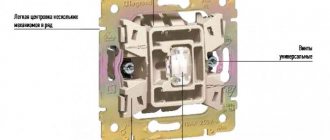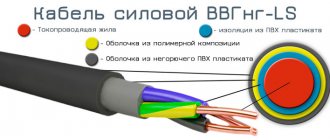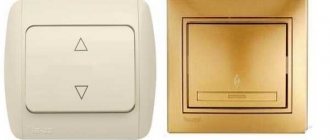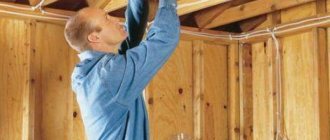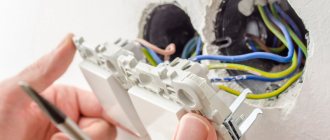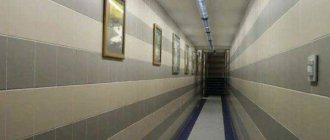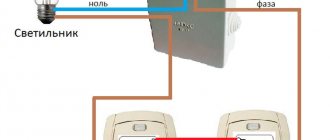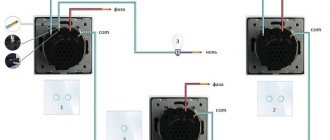Connection diagram for pass-through switch widely used in modern buildings with large spaces. This is typical for cases when it is necessary to turn a light bulb on and off, for example, from remote points located in different parts of the apartment.
Thanks to this combination, it is possible to turn on the lighting with one of the devices when entering a room, and with the help of a second device it will be possible to turn off the same lighting when leaving the other end of the room.
Principle of operation
Walk-through switches are no different in appearance from conventional key switches - their design and principle of operation have their own specifics. The main differences between these switching devices are the number and order of connection of the switching contacts.
Please note: When a conventional single light switch is triggered, the phase circuit in which the switching device is connected is simply closed or opened.
When operating 2-pass switches, the order of breaking and closing the chain supplying phase voltage to the lighting device is more complex and branched. During the switching process, two such switches, the diagram of which is discussed below, close one of the connecting lines while simultaneously opening the other.
Due to this, it is possible to implement the principle of separate control of the same lighting device from two places located at a considerable distance from one another. The most typical example of such an organization is the location of switches at opposite ends of a long corridor. This feature ultimately determines the specifics of installation of walk-through switches within the boundaries of a particular inhabited room.
Why are pass-through switches needed?
Most often, such switches are used in the following places:
- on the stairs. You can install switches on the 1st and 2nd floors. We turn on the lights at the bottom, go up the stairs, and turn them off at the top. For houses with a height of more than two floors, additional switches can be added to the circuit;
- in the bedrooms. We install a switch at the entrance to the room, and another one or even two near the bed. We entered the bedroom, turned on the light, got ready for bed, lay down and turned off the lighting with a device installed near the bed;
- in the corridors. We install a switch at the beginning and at the end of the corridor. We go in, turn on the light, reach the end, turn it off.
The list can be continued for a very long time, because for almost every situation there is its own option for using a pass-through switch system.
Advantages and disadvantages
pros
- Energy saving;
- Ease of use in long corridors and bedrooms.
Minuses
- Electrical skills required;
- Pass-through switches are much more expensive than conventional switches.
Connection diagrams
The order of connecting devices included in the remote control system is determined by the switching features of the pass-through switches. Let's take a closer look at the principle of their operation.
Electrical diagram
The operating procedure of the system under consideration is most conveniently explained if we use the electrical diagram for connecting a single-key pass-through switch.
According to this figure, the pass-through switches are connected by two linear conductors connecting the switching points. In this case, their changeover contacts are initially in opposite positions and connected to unused linear wires.
Upon entering the room, the switch plate of the first device is moved to a position in which the power supply circuit of the illuminator is closed. As a result of this, it turns on. At the exit of the room, the key of the second single-key switch is switched to the “Off” position, so that the previously formed power circuit is interrupted and the light goes out.
Experts advise, even before connecting the pass-through switches, the diagram of which is discussed above, to specifically provide two points for their placement in the apartment.
Installation diagram with distribution box
An installation or working diagram for connecting a pass-through switch with a detailed drawing of all the conductors used in it allows you to visualize the general order of formation of connections. In addition, it helps to understand how the distribution (connection) boxes located in the apartment relate to this. The electrical connection diagram for all of the listed elements is shown in the photo below.
By using a standard distribution box, indicated in the figure as a circle, it is possible to electrically disconnect the individual conductors of a system of two switching devices. In this diagram, blue and yellow colors show the conductors that supply zero and phase to the light bulb, respectively, and black colors show the internal switching chains.
We invite you to watch a video on how to connect two pass-through switches without a distribution box:
Lighting control from three places or more
There are often situations when in large residential premises there is a need to control lighting from several points at once. To create a multi-point control system that allows you to turn on and off lights from 3 places at the same time, installing pass-through switches alone is usually not enough.
For these purposes, you will need to integrate one more element into the circuit - cross switch , which is connected at the break of the two-core wire (that is, between pass-through devices).
If in earlier times the permissibility of installing such schemes was determined mainly by the layout of the premises, today they are found almost everywhere. Installing pass-through switches of this type is not an easy task. First of all, you need to familiarize yourself with the principle of its operation.
Operating principle of a cross switch (switch)
The design of the switch provides for the presence of four contacts, of which two are connected to the terminals of one switch and two more to the second device.
Please note: The main difference between crossover switches and pass-through switches is that they can only be used in conjunction with pass-through switches.
When switched on in this way, these devices perform special (transit) functions, since they are to a certain extent transitional.
You can clearly see the principle of operation of the cross switch in the GIF picture below.
Connection diagram for pass-through switch for control from 3 places
A schematic diagram of connecting a 2-way switch and one crossover switch is shown in the figure.
It clearly shows that a cross switch is installed between the two pass-through switches, acting as a kind of transit node.
Below is a wiring diagram for a pass-through switch, which shows the connections of all elements of the electrical lighting control chain in the distribution box.
The video that we have posted below will undoubtedly help you assemble a wiring diagram for three switches in a junction box.
Connection diagram for pass-through switch for control from 4 places
For four control points, you will need to use the complex wiring diagram shown in the figure below. This kit uses not only two pass-through switches, but also a pair of cross-type switches.
When considering the option of controlling a lamp from 4 places at once, two cross switching devices will be required.
If there are several lighting groups in a given room, preference should be given to two-key cross-type switches. Passage systems installed in this way significantly simplify the lighting control procedure.
Connection diagram for pass-through switch for control from 5 places
To control lighting from five points, you will need two pass-through switches and three cross switches. The connection diagram will look like this:
Lighting control circuit from five places or more using pass-through and cross switches (1 and 2 - pass-through, x1, x2 ... xn - cross)
Switches or switches: what to choose?
Before you go to the store to buy fixtures for installing lamps, you should understand the types of devices that are used for electrical wiring.
Most beginners do not understand the differences between switches and switches; they may think that they are the same device. However, these devices have only external similarities, but the internal structure is different. Such switches have different operating principles.
Switches and switches for household electrical networks do not differ in external structure, but they are intended for different circuits
A standard switch is a simple device that is required to open and close an electrical circuit. It has one incoming and one outgoing conductor. Of course, there are multi-key devices, but this is a complex system that consists of several switches in one.
A switch is a switching device in which there is one incoming chain and several more of the same outgoing ones. It turns out that this device seems to throw the contact into different positions, which is why it is also called a changeover device.
If it is a simple device with one button, then it has three clamps - incoming and two outgoing. Accordingly, if there are two buttons, then there are six clamps.
The word pass-through switch means a system that consists of switches united by a common circuit. Such a switching device is mounted on the same lamp, allowing it to be turned on and off from different parts of the room.
It is impossible to make a pass-through switch from a standard device, because this requires a switch
Important. As a result, a device with two contacts is designed to open the common circuit with the phase conductor from which the lighting device receives power. A switch with three contacts is used to organize additional power circuits. It turns out that the first type is required to stop the flow of current through the chain, and the second, in order to switch across the chains.
However, upon external inspection, a person without relevant experience will not be able to distinguish these switches. After all, this is a standard plastic device - single-key or multi-key. In this case, it will be possible to use the switch as a standard switch, but not vice versa. After all, it will no longer be possible to make a device with two contacts into a three-contact one. At the same time, it is quite possible not to use one chain. However, in order to control the light from different places, you need to purchase a switch.
Electronic devices
To control their lighting fixtures from many points, the apartment owner can use both key switches and electronic devices.
One such device is KillerSwitch, a Russian-made device for turning lights on and off from different locations.
This electronic device operates in two modes depending on the type of switches:
- Using classic key or push-button switches with latching without backlight. In this case, you can connect from 1 to 3 switches.
- Using key or push-button switches without fixation.
To change the operating mode of the device, you must remove or install the jumper.
Connection diagrams for the KillerSwitch electronic device
Connection diagram for latching switches
Connection diagram for momentary switches
We bring to your attention a video about the connection procedure and operation of the KillerSwitch electronic device.
These systems of many switched devices (for all their apparent convenience) raise doubts about their reliability to an even greater extent. Even if they are turned on correctly and handled with care, they are characterized by the following disadvantages:
- relatively high cost;
- relatively low reliability;
- possibility of false positives;
- difficulty of maintenance and repair.
That is why connecting pass-through and cross switches to control lighting from several places is the best option for using the principle of multipoint control.
Well-known manufacturers of pass-through switches
The Legrand company occupies a leading position in the electrical goods market. The demand for Legrand pass-through switches is due to the high quality of the products, ease of installation, ease of further operation, stylish design and flexible pricing policy. The only drawback is the need to adjust the installation location. If it does not coincide with the product, difficulties may arise during its installation, which is carried out according to the connection diagram for the Legrand pass-through switch.
Legrand pass-through switches
A subsidiary of Legrand is the Chinese company Lezard. However, the products have only a stylish design left from their native brand. The build quality is much lower, which is due to the low cost of the products.
One of the leading domestic manufacturers of electrical goods is the Wessen company, which is part of the Schneider Electric company. All products are manufactured using the latest technologies on modern foreign equipment and comply with European quality standards. The models have a universal, stylish design that allows each element to fit into any interior of the room. A distinctive feature of Wessen switches is the ability to replace the decorative frame without dismantling the device.
Another equally well-known manufacturer is the Turkish company Viko. The products are characterized by high quality workmanship, reliability and durability, and comply with electrical safety requirements and European quality standards. In the manufacture of the device body, fireproof durable plastic is used, which is designed for a large number of operating cycles.
A pass-through switch, unlike a regular switch, has three conductive wires
The Turkish brand Makel offers high-quality, reliable, safe and stylish products. Thanks to the ability to connect a cable without the need to use a distribution box, installation of switches becomes simpler, and further operation becomes comfortable and safe.
Popular range of pass-through switches
Legrand pass-through switches from the Velena series are distinguished by their stylish design and a variety of color variations. Here are one- and two-key products that have a dust- and moisture-proof layer. You can buy a switch from 300 rubles.
The Celiane series includes products with circular keys inscribed in a square. They can be non-contact with levers or silent. The cost of switches starts from 700 rubles. The Exclusive Celiane range features a limited number of switches handcrafted from marble, bamboo, porcelain, gold, myrtle and other materials. Frames are made exclusively to order. The price for the product starts from 5.9 thousand rubles.
Color solutions for switches from the Celiane series
The most popular series of switches from Lezard are Demet, Mira and Deriy. Here are products made from non-flammable polycarbonate, which meets electrical safety requirements. The conductive elements are made of phosphor bronze, which is characterized by high conductivity and low heating. You can buy a pass-through single-key switch from 125 rubles.
The W 59 Frame series from Wessen uses a modular principle, allowing you to install from 1 to 4 devices in one frame horizontally or vertically. The price of the product is 140 rubles. Single and double pass-through switches from the Asfora series are distinguished by a simple design, but high quality workmanship, which can be purchased for 450 rubles.
Among the popular series of the Makel company we can highlight Defne and Makel Mimoza. The device body is made of high-quality plastic, equipped with an internal reliable mechanism. The cost of products starts from 150 rubles.
When you press the on/off button, the moving contact of the pass-through switch switches from one contact to another, thereby creating the conditions for a new circuit in the future
The operating principle and installation of switching devices do not pose any significant difficulties. It is necessary to first study the connection diagram and follow the recommendations of electrical safety rules, which will make it possible to carry out reliable and safe installation of devices, thereby ensuring convenient and comfortable control of lighting devices in the house.
How to connect a pass-through switch: video connection diagrams
Pass-through switch: diagram for connecting a device from different places
Share the news on social networks
- Related Posts
- Installing a mosquito net is the best way to protect your home from insects
- Wall-mounted clothes dryers: the best choice for small spaces
- Electricity meter readings: transmit data in the most convenient way
« Previous entry
Sensory Modifications
Currently, owners of apartments and private houses are increasingly using touch switches to furnish their premises. The line of this type of product also includes touch-sensitive pass-through switches .
The devices not only increase the level of comfort, but are also stylish design elements.
Touch switches in the interior
Below we provide some connection diagrams for touch pass-through switches.
Connection diagram for two pass-through touch switches
Connection diagram for three pass-through touch switches
To learn how to connect and sync pass-through touch switches, you can watch the video below.
conclusions
When analyzing all the connection diagrams for pass-through switches discussed in this review, the following can be noted:
- The simplest of these systems provide undeniable advantages and do not have any noticeable disadvantages (this applies to a pass-through switch with one key, in particular).
- More complex complexes, which also include crossover devices, may not be as effective as they seem.
- This is explained by the fact that even taking into account the ease of management, their use is associated with high costs and a decrease in the reliability of the entire system as a whole.
- When installing switching circuits in which switches are arranged in a daisy chain, you will need to carefully monitor the order of switching in order to prevent critical errors.
- This should also be attributed to the disadvantages of complex kits that include crossover switches.
In the final part of the review, we note that when arranging such systems one has to deal with certain difficulties in laying linear conductors. When choosing an installation method, there are options for hiding them deep in the walls or using special cable channels for this. If the owner of a private house plans to “hide” the wires deep into the walls, he should worry about this in advance (preferably at the stage of developing the construction project).
Types of switching devices
Switches differ from each other in several ways. In order to choose the appropriate option, you need to familiarize yourself with them in more detail - we will present the necessary information in the form of a table.
Table No. 1. Types of switches.
| View | Description |
| Push-button | As a rule, such a device is suitable for call control, so it is installed near the entrance. However, it is not used to control luminaires. |
| Keyboards | This is a standard option that is used to open and close circuits in household electrical networks. |
| Rotary | Such switches are also sometimes installed in residential premises, but most often they can be found in production. After all, they do not have such an aesthetic appearance as the previous options. |
As we have already said, there are single-key devices, as well as two-key and three-key devices. They, in turn, are divided into standard, combined type and intermediate devices.
In the first case we are talking about three-pin switches, in the second the number of clamps differs in the number of keys. The third option is intended for complex circuits where it is necessary to organize more than two switching points.
In private houses or apartments in multi-story buildings, devices with keys are often installed
Sometimes devices are mounted with touch control or remote control. The third option has gained popularity in recent years.
Important. In addition, there are switches with a motion sensor. This is a combined electrical device that responds to movement in a certain area. Such switches are installed both in residential premises and outdoors. After all, this provides additional security. You can read about how to connect a motion sensor in our special article.
According to the method of laying electrical wiring, switches are divided into the following types:
- external (surface switches);
- built-in (hidden).
In the first case, you will need to attach the device directly to the ceiling with screws. The second option involves a fastening method using special lugs that are located at the edges.
Prices for pass-through single-key switches
Single-key pass-through switch
Video - Pass-through switch or impulse relay?
If you need to choose the optimal switch option if you have a pass-through device circuit, then you should correctly determine the number of keys (each group of devices must have one key). If you are going to organize only two points to control the lamp, then purchase a standard switch with three contacts. If a larger number of points is required, you will have to purchase additional devices to connect to the common chain.
Most often, devices with a key have only two positions - on and off. However, equipment is commercially available with an additional central position (zero), which is designed to open these two circuits.
Designations on the device body
On the body of the switching device, where the contacts are located, there is usually a marking with the characteristics of the device. The voltage, rated current and degree of protection of the product are indicated here.
Switches
For standard light bulbs, you must choose a device marked “A”. If you plan to install gas light lamps, then you should choose a switch marked “AX”.
When the light in gas lighting fixtures is turned on, a sharp fluctuation in inrush currents occurs. When installing standard bulbs and LED bulbs, the fluctuation will not be so pronounced. It turns out that the switch must be designed for such a load, otherwise the possibility of melting of the contacts in the terminals cannot be ruled out. Therefore, in the case of gas light lamps, an appropriate device is required.
Important. Of no small importance is the degree of protection of the device - IP. If you plan to install the device in the hallway or bedroom, then the degree of protection - “2” is sufficient. If you need to install the switch in a room with high humidity, then protection up to “55” is required.
The terminals for fixing electrical wiring also differ from each other:
- on screws with a pressure plate;
- without screws with spring.
The first fixation option is considered durable, and the second is easy to install, which is why switches with screws and a pressure plate are popular - when fixed, they do not violate the integrity of the conductor core.
If the wire has a diameter of one and a half millimeters, then a switch with screws is not used to connect it
In addition, on the device body there are clamp designations:
- “N” – for neutral wire;
- “L” – for phase wire;
- “ground” – for the grounding conductor.
In addition, there are other markings on the device - this may be the value of opening and closing the circuit, the manufacturer’s logo.
Prices for walk-through two-key switches
Two-key pass-through switch

